Perioperative Care: Factors Influencing, Enhancement Strategies
VerifiedAdded on 2019/09/30
|10
|2642
|138
Report
AI Summary
This report delves into the multifaceted aspects of perioperative care, highlighting the significant impact of surgical procedures on healthcare and patient outcomes. It examines factors that influence the safety and quality of perioperative care, including the crucial role of teamwork among healthcare professionals, particularly nursing staff, in monitoring patient health and communicating effectively. The report emphasizes the application of quality and safety frameworks, such as consumer-centered care, information-driven practices, and organized safety measures. It details perioperative nursing interventions across preoperative, intraoperative, and postoperative phases, underscoring the importance of communication, critical thinking, and self-management skills for healthcare professionals. Furthermore, it addresses barriers to effective communication and collaboration, proposing strategies to improve patient safety and enhance the overall quality of perioperative care.
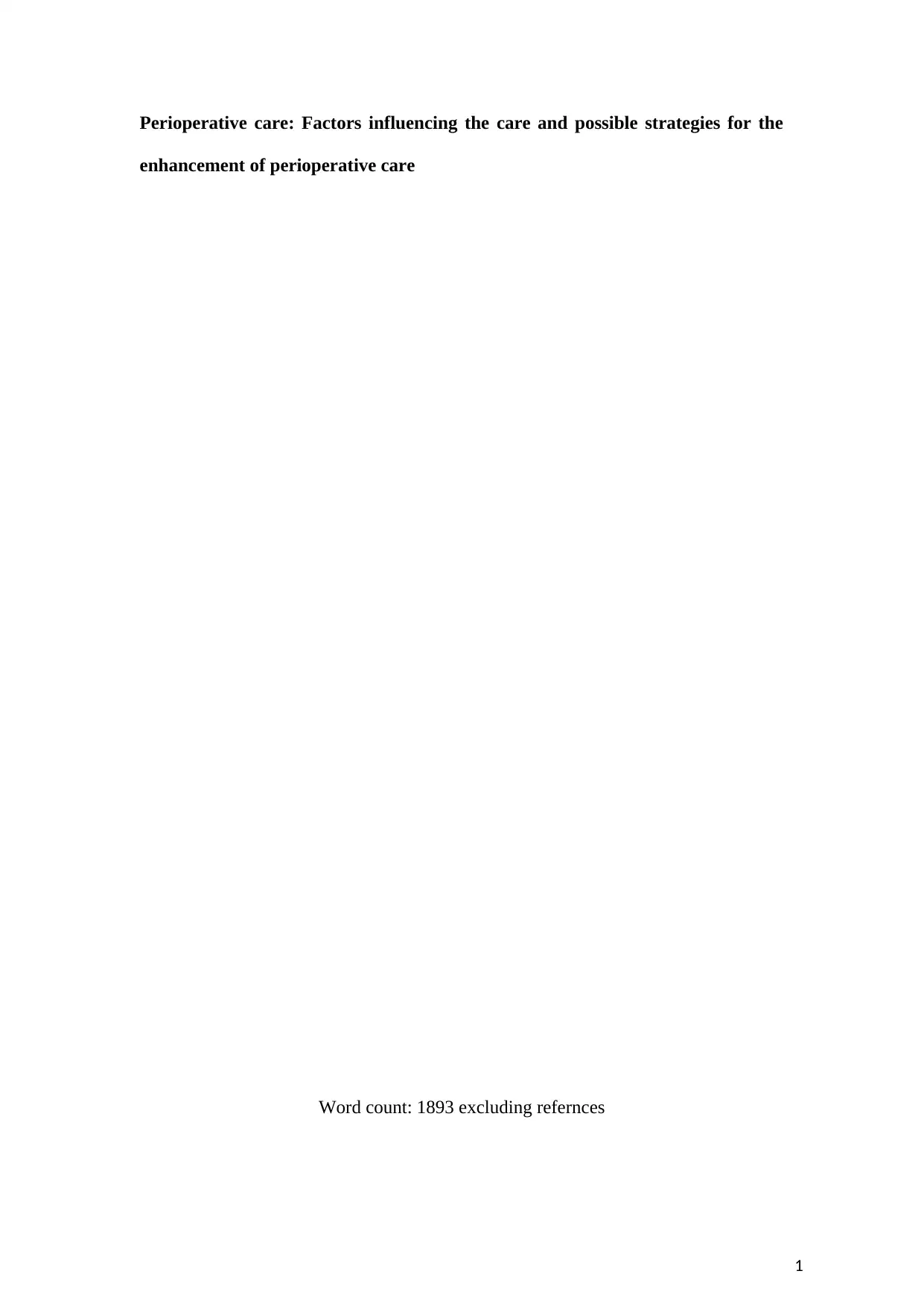
1
Perioperative care: Factors influencing the care and possible strategies for the
enhancement of perioperative care
Word count: 1893 excluding refernces
Perioperative care: Factors influencing the care and possible strategies for the
enhancement of perioperative care
Word count: 1893 excluding refernces
Paraphrase This Document
Need a fresh take? Get an instant paraphrase of this document with our AI Paraphraser
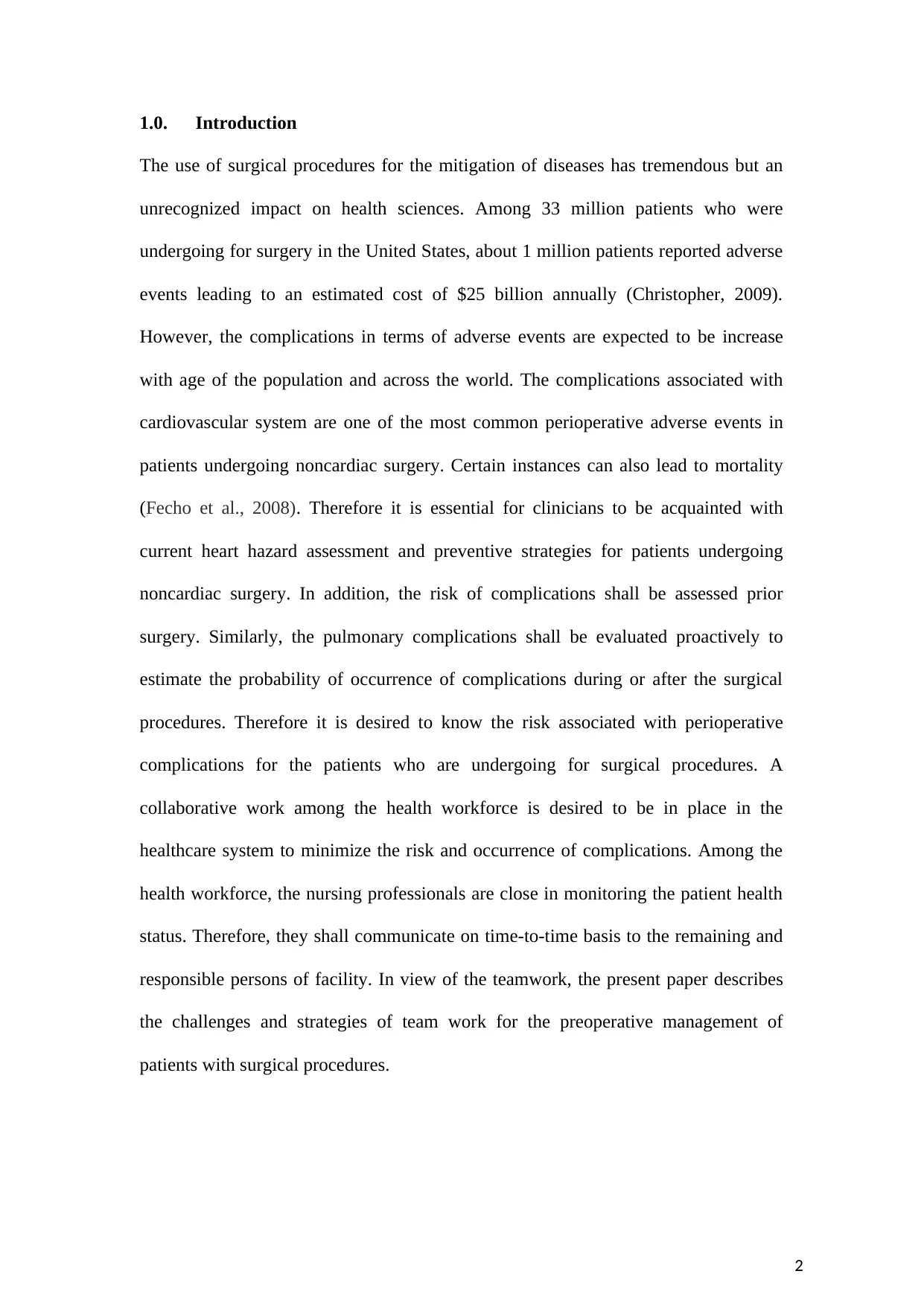
2
1.0. Introduction
The use of surgical procedures for the mitigation of diseases has tremendous but an
unrecognized impact on health sciences. Among 33 million patients who were
undergoing for surgery in the United States, about 1 million patients reported adverse
events leading to an estimated cost of $25 billion annually (Christopher, 2009).
However, the complications in terms of adverse events are expected to be increase
with age of the population and across the world. The complications associated with
cardiovascular system are one of the most common perioperative adverse events in
patients undergoing noncardiac surgery. Certain instances can also lead to mortality
(Fecho et al., 2008). Therefore it is essential for clinicians to be acquainted with
current heart hazard assessment and preventive strategies for patients undergoing
noncardiac surgery. In addition, the risk of complications shall be assessed prior
surgery. Similarly, the pulmonary complications shall be evaluated proactively to
estimate the probability of occurrence of complications during or after the surgical
procedures. Therefore it is desired to know the risk associated with perioperative
complications for the patients who are undergoing for surgical procedures. A
collaborative work among the health workforce is desired to be in place in the
healthcare system to minimize the risk and occurrence of complications. Among the
health workforce, the nursing professionals are close in monitoring the patient health
status. Therefore, they shall communicate on time-to-time basis to the remaining and
responsible persons of facility. In view of the teamwork, the present paper describes
the challenges and strategies of team work for the preoperative management of
patients with surgical procedures.
1.0. Introduction
The use of surgical procedures for the mitigation of diseases has tremendous but an
unrecognized impact on health sciences. Among 33 million patients who were
undergoing for surgery in the United States, about 1 million patients reported adverse
events leading to an estimated cost of $25 billion annually (Christopher, 2009).
However, the complications in terms of adverse events are expected to be increase
with age of the population and across the world. The complications associated with
cardiovascular system are one of the most common perioperative adverse events in
patients undergoing noncardiac surgery. Certain instances can also lead to mortality
(Fecho et al., 2008). Therefore it is essential for clinicians to be acquainted with
current heart hazard assessment and preventive strategies for patients undergoing
noncardiac surgery. In addition, the risk of complications shall be assessed prior
surgery. Similarly, the pulmonary complications shall be evaluated proactively to
estimate the probability of occurrence of complications during or after the surgical
procedures. Therefore it is desired to know the risk associated with perioperative
complications for the patients who are undergoing for surgical procedures. A
collaborative work among the health workforce is desired to be in place in the
healthcare system to minimize the risk and occurrence of complications. Among the
health workforce, the nursing professionals are close in monitoring the patient health
status. Therefore, they shall communicate on time-to-time basis to the remaining and
responsible persons of facility. In view of the teamwork, the present paper describes
the challenges and strategies of team work for the preoperative management of
patients with surgical procedures.
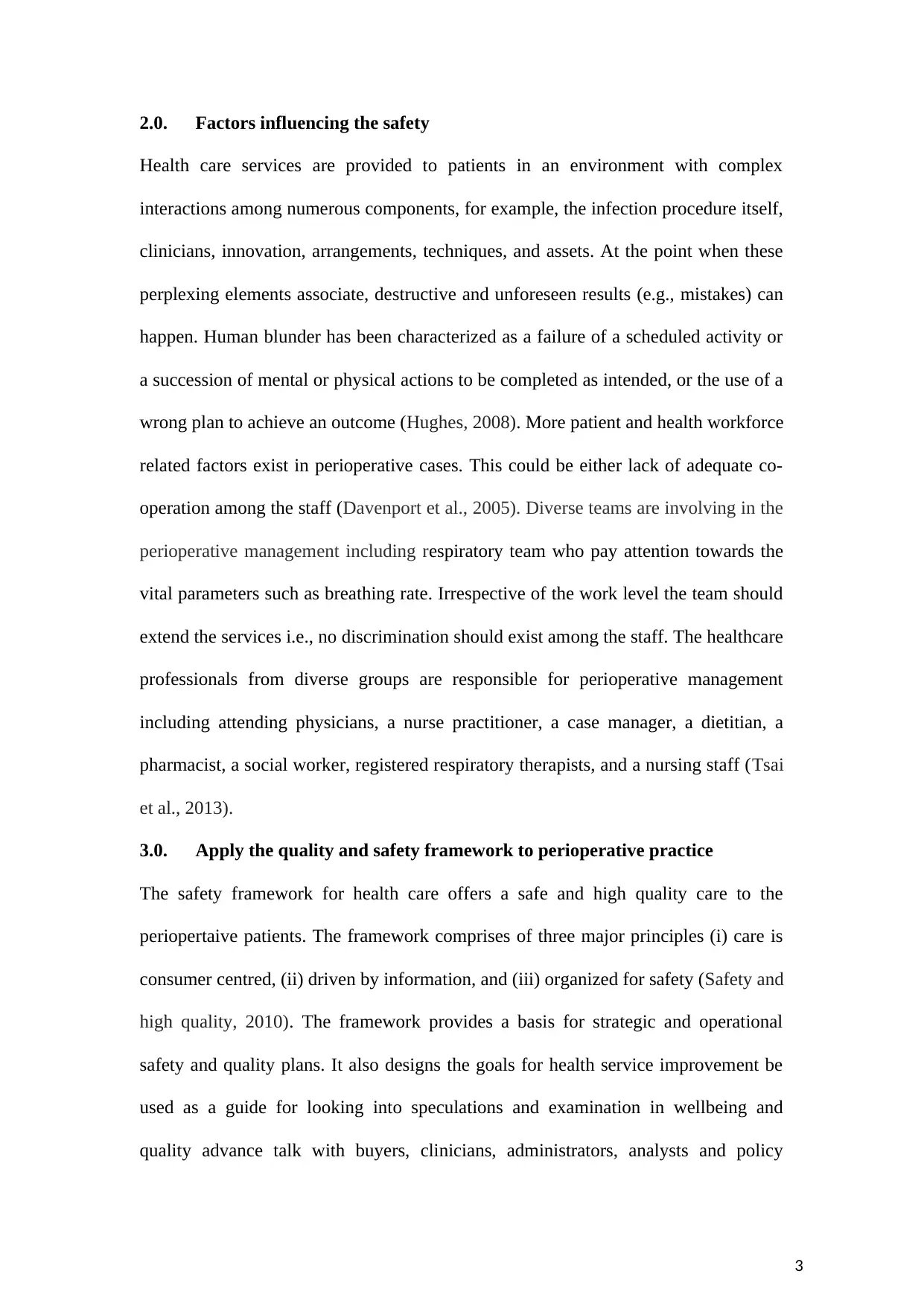
3
2.0. Factors influencing the safety
Health care services are provided to patients in an environment with complex
interactions among numerous components, for example, the infection procedure itself,
clinicians, innovation, arrangements, techniques, and assets. At the point when these
perplexing elements associate, destructive and unforeseen results (e.g., mistakes) can
happen. Human blunder has been characterized as a failure of a scheduled activity or
a succession of mental or physical actions to be completed as intended, or the use of a
wrong plan to achieve an outcome (Hughes, 2008). More patient and health workforce
related factors exist in perioperative cases. This could be either lack of adequate co-
operation among the staff (Davenport et al., 2005). Diverse teams are involving in the
perioperative management including respiratory team who pay attention towards the
vital parameters such as breathing rate. Irrespective of the work level the team should
extend the services i.e., no discrimination should exist among the staff. The healthcare
professionals from diverse groups are responsible for perioperative management
including attending physicians, a nurse practitioner, a case manager, a dietitian, a
pharmacist, a social worker, registered respiratory therapists, and a nursing staff (Tsai
et al., 2013).
3.0. Apply the quality and safety framework to perioperative practice
The safety framework for health care offers a safe and high quality care to the
periopertaive patients. The framework comprises of three major principles (i) care is
consumer centred, (ii) driven by information, and (iii) organized for safety (Safety and
high quality, 2010). The framework provides a basis for strategic and operational
safety and quality plans. It also designs the goals for health service improvement be
used as a guide for looking into speculations and examination in wellbeing and
quality advance talk with buyers, clinicians, administrators, analysts and policy
2.0. Factors influencing the safety
Health care services are provided to patients in an environment with complex
interactions among numerous components, for example, the infection procedure itself,
clinicians, innovation, arrangements, techniques, and assets. At the point when these
perplexing elements associate, destructive and unforeseen results (e.g., mistakes) can
happen. Human blunder has been characterized as a failure of a scheduled activity or
a succession of mental or physical actions to be completed as intended, or the use of a
wrong plan to achieve an outcome (Hughes, 2008). More patient and health workforce
related factors exist in perioperative cases. This could be either lack of adequate co-
operation among the staff (Davenport et al., 2005). Diverse teams are involving in the
perioperative management including respiratory team who pay attention towards the
vital parameters such as breathing rate. Irrespective of the work level the team should
extend the services i.e., no discrimination should exist among the staff. The healthcare
professionals from diverse groups are responsible for perioperative management
including attending physicians, a nurse practitioner, a case manager, a dietitian, a
pharmacist, a social worker, registered respiratory therapists, and a nursing staff (Tsai
et al., 2013).
3.0. Apply the quality and safety framework to perioperative practice
The safety framework for health care offers a safe and high quality care to the
periopertaive patients. The framework comprises of three major principles (i) care is
consumer centred, (ii) driven by information, and (iii) organized for safety (Safety and
high quality, 2010). The framework provides a basis for strategic and operational
safety and quality plans. It also designs the goals for health service improvement be
used as a guide for looking into speculations and examination in wellbeing and
quality advance talk with buyers, clinicians, administrators, analysts and policy
⊘ This is a preview!⊘
Do you want full access?
Subscribe today to unlock all pages.

Trusted by 1+ million students worldwide
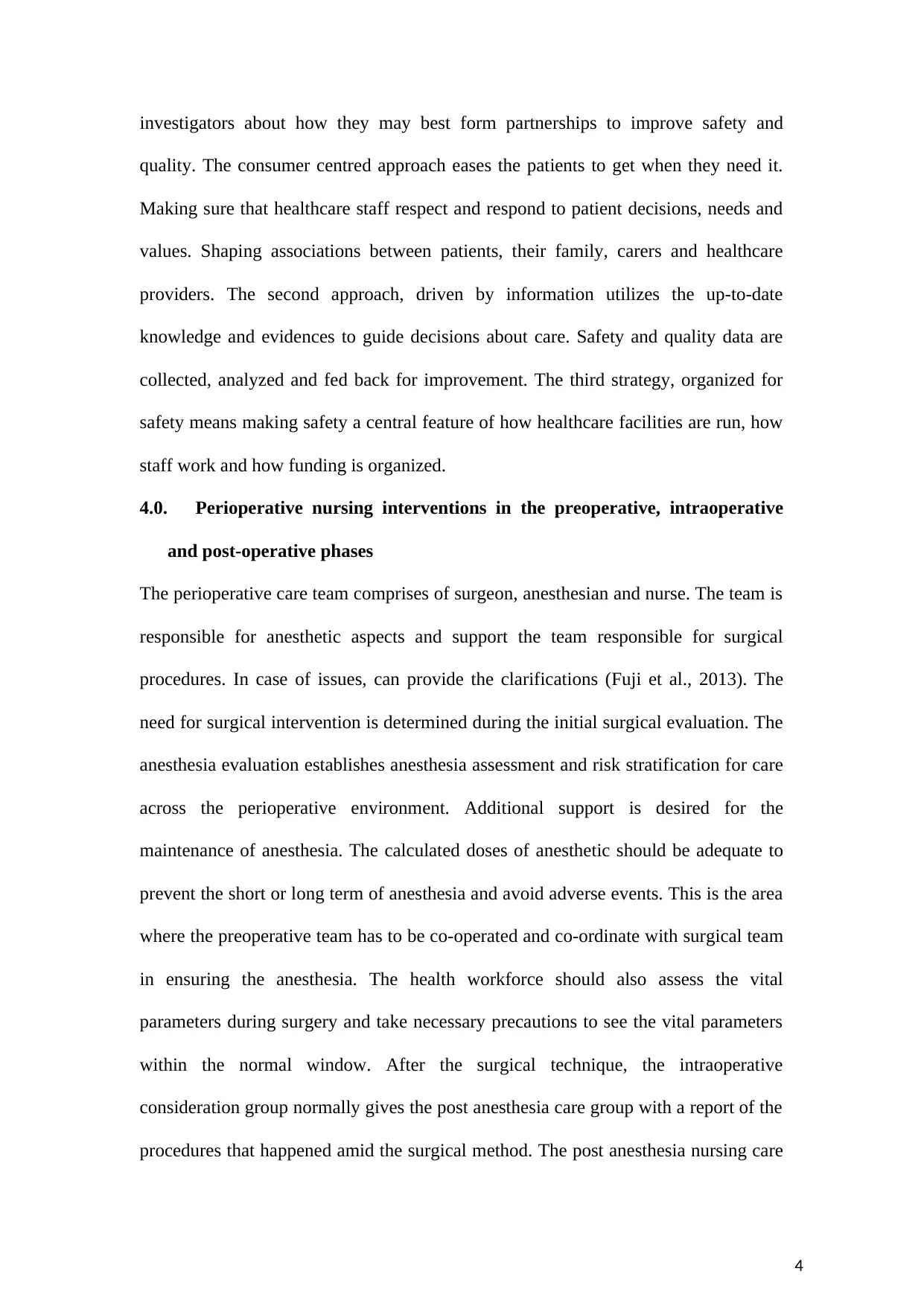
4
investigators about how they may best form partnerships to improve safety and
quality. The consumer centred approach eases the patients to get when they need it.
Making sure that healthcare staff respect and respond to patient decisions, needs and
values. Shaping associations between patients, their family, carers and healthcare
providers. The second approach, driven by information utilizes the up-to-date
knowledge and evidences to guide decisions about care. Safety and quality data are
collected, analyzed and fed back for improvement. The third strategy, organized for
safety means making safety a central feature of how healthcare facilities are run, how
staff work and how funding is organized.
4.0. Perioperative nursing interventions in the preoperative, intraoperative
and post-operative phases
The perioperative care team comprises of surgeon, anesthesian and nurse. The team is
responsible for anesthetic aspects and support the team responsible for surgical
procedures. In case of issues, can provide the clarifications (Fuji et al., 2013). The
need for surgical intervention is determined during the initial surgical evaluation. The
anesthesia evaluation establishes anesthesia assessment and risk stratification for care
across the perioperative environment. Additional support is desired for the
maintenance of anesthesia. The calculated doses of anesthetic should be adequate to
prevent the short or long term of anesthesia and avoid adverse events. This is the area
where the preoperative team has to be co-operated and co-ordinate with surgical team
in ensuring the anesthesia. The health workforce should also assess the vital
parameters during surgery and take necessary precautions to see the vital parameters
within the normal window. After the surgical technique, the intraoperative
consideration group normally gives the post anesthesia care group with a report of the
procedures that happened amid the surgical method. The post anesthesia nursing care
investigators about how they may best form partnerships to improve safety and
quality. The consumer centred approach eases the patients to get when they need it.
Making sure that healthcare staff respect and respond to patient decisions, needs and
values. Shaping associations between patients, their family, carers and healthcare
providers. The second approach, driven by information utilizes the up-to-date
knowledge and evidences to guide decisions about care. Safety and quality data are
collected, analyzed and fed back for improvement. The third strategy, organized for
safety means making safety a central feature of how healthcare facilities are run, how
staff work and how funding is organized.
4.0. Perioperative nursing interventions in the preoperative, intraoperative
and post-operative phases
The perioperative care team comprises of surgeon, anesthesian and nurse. The team is
responsible for anesthetic aspects and support the team responsible for surgical
procedures. In case of issues, can provide the clarifications (Fuji et al., 2013). The
need for surgical intervention is determined during the initial surgical evaluation. The
anesthesia evaluation establishes anesthesia assessment and risk stratification for care
across the perioperative environment. Additional support is desired for the
maintenance of anesthesia. The calculated doses of anesthetic should be adequate to
prevent the short or long term of anesthesia and avoid adverse events. This is the area
where the preoperative team has to be co-operated and co-ordinate with surgical team
in ensuring the anesthesia. The health workforce should also assess the vital
parameters during surgery and take necessary precautions to see the vital parameters
within the normal window. After the surgical technique, the intraoperative
consideration group normally gives the post anesthesia care group with a report of the
procedures that happened amid the surgical method. The post anesthesia nursing care
Paraphrase This Document
Need a fresh take? Get an instant paraphrase of this document with our AI Paraphraser
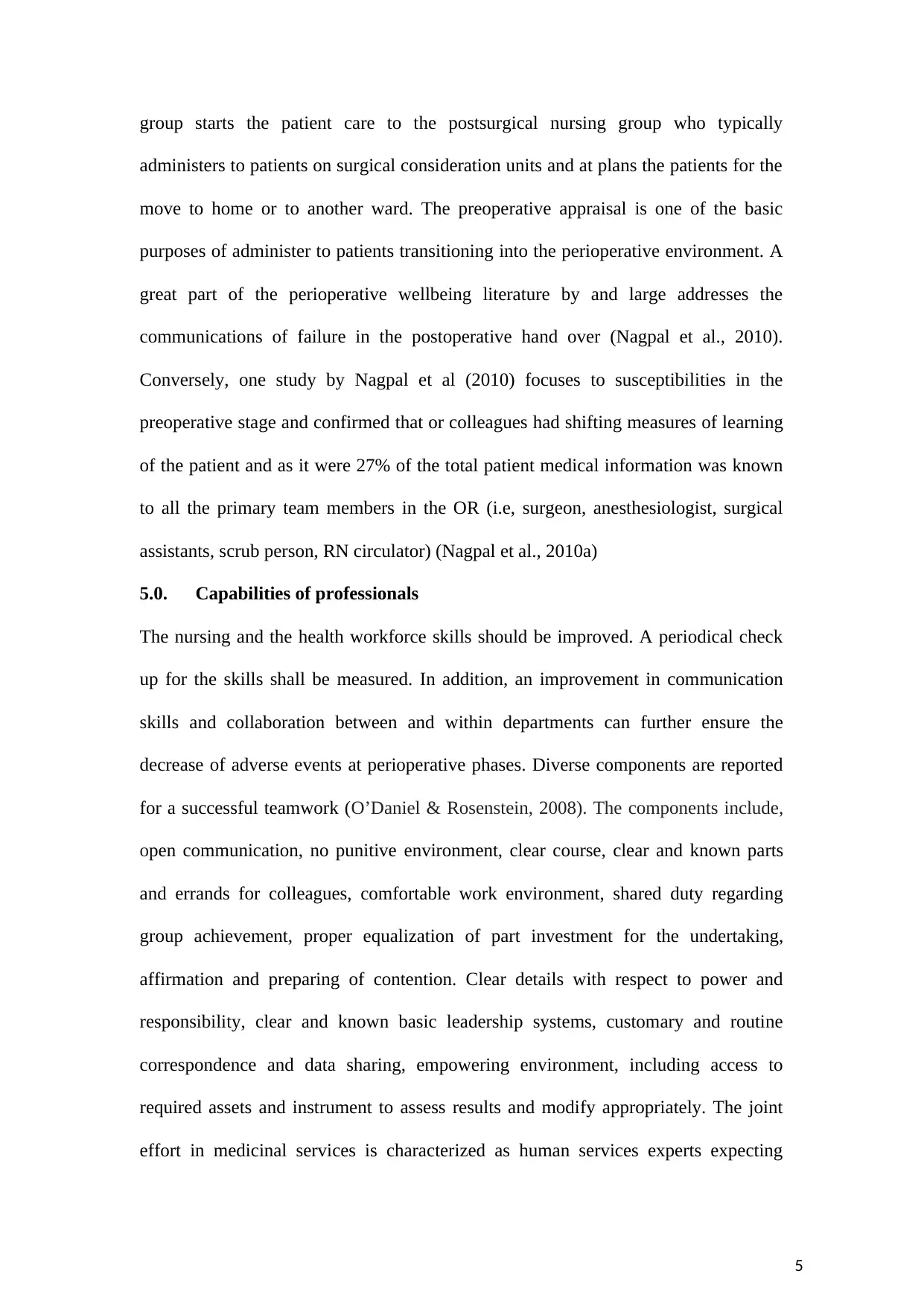
5
group starts the patient care to the postsurgical nursing group who typically
administers to patients on surgical consideration units and at plans the patients for the
move to home or to another ward. The preoperative appraisal is one of the basic
purposes of administer to patients transitioning into the perioperative environment. A
great part of the perioperative wellbeing literature by and large addresses the
communications of failure in the postoperative hand over (Nagpal et al., 2010).
Conversely, one study by Nagpal et al (2010) focuses to susceptibilities in the
preoperative stage and confirmed that or colleagues had shifting measures of learning
of the patient and as it were 27% of the total patient medical information was known
to all the primary team members in the OR (i.e, surgeon, anesthesiologist, surgical
assistants, scrub person, RN circulator) (Nagpal et al., 2010a)
5.0. Capabilities of professionals
The nursing and the health workforce skills should be improved. A periodical check
up for the skills shall be measured. In addition, an improvement in communication
skills and collaboration between and within departments can further ensure the
decrease of adverse events at perioperative phases. Diverse components are reported
for a successful teamwork (O’Daniel & Rosenstein, 2008). The components include,
open communication, no punitive environment, clear course, clear and known parts
and errands for colleagues, comfortable work environment, shared duty regarding
group achievement, proper equalization of part investment for the undertaking,
affirmation and preparing of contention. Clear details with respect to power and
responsibility, clear and known basic leadership systems, customary and routine
correspondence and data sharing, empowering environment, including access to
required assets and instrument to assess results and modify appropriately. The joint
effort in medicinal services is characterized as human services experts expecting
group starts the patient care to the postsurgical nursing group who typically
administers to patients on surgical consideration units and at plans the patients for the
move to home or to another ward. The preoperative appraisal is one of the basic
purposes of administer to patients transitioning into the perioperative environment. A
great part of the perioperative wellbeing literature by and large addresses the
communications of failure in the postoperative hand over (Nagpal et al., 2010).
Conversely, one study by Nagpal et al (2010) focuses to susceptibilities in the
preoperative stage and confirmed that or colleagues had shifting measures of learning
of the patient and as it were 27% of the total patient medical information was known
to all the primary team members in the OR (i.e, surgeon, anesthesiologist, surgical
assistants, scrub person, RN circulator) (Nagpal et al., 2010a)
5.0. Capabilities of professionals
The nursing and the health workforce skills should be improved. A periodical check
up for the skills shall be measured. In addition, an improvement in communication
skills and collaboration between and within departments can further ensure the
decrease of adverse events at perioperative phases. Diverse components are reported
for a successful teamwork (O’Daniel & Rosenstein, 2008). The components include,
open communication, no punitive environment, clear course, clear and known parts
and errands for colleagues, comfortable work environment, shared duty regarding
group achievement, proper equalization of part investment for the undertaking,
affirmation and preparing of contention. Clear details with respect to power and
responsibility, clear and known basic leadership systems, customary and routine
correspondence and data sharing, empowering environment, including access to
required assets and instrument to assess results and modify appropriately. The joint
effort in medicinal services is characterized as human services experts expecting
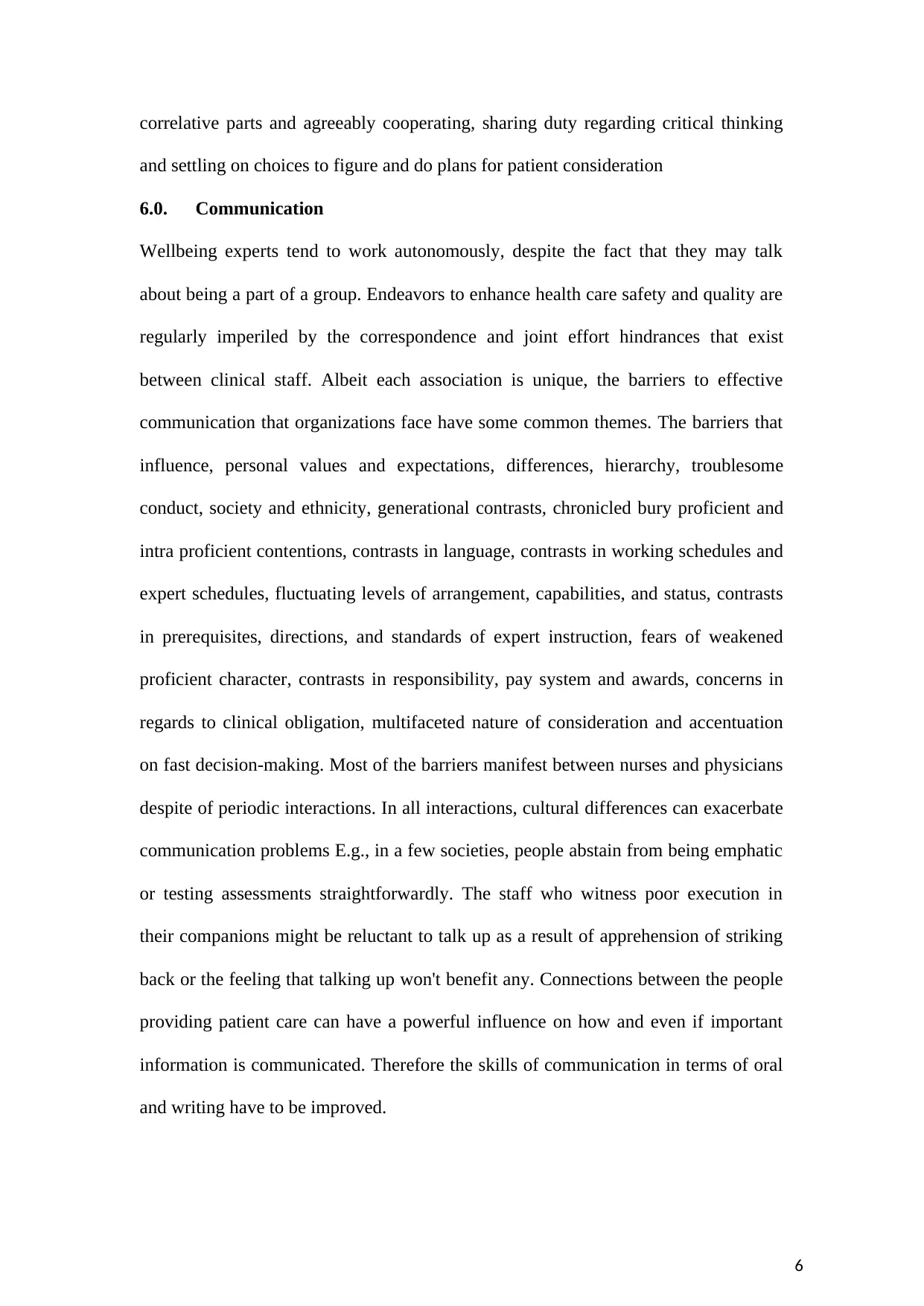
6
correlative parts and agreeably cooperating, sharing duty regarding critical thinking
and settling on choices to figure and do plans for patient consideration
6.0. Communication
Wellbeing experts tend to work autonomously, despite the fact that they may talk
about being a part of a group. Endeavors to enhance health care safety and quality are
regularly imperiled by the correspondence and joint effort hindrances that exist
between clinical staff. Albeit each association is unique, the barriers to effective
communication that organizations face have some common themes. The barriers that
influence, personal values and expectations, differences, hierarchy, troublesome
conduct, society and ethnicity, generational contrasts, chronicled bury proficient and
intra proficient contentions, contrasts in language, contrasts in working schedules and
expert schedules, fluctuating levels of arrangement, capabilities, and status, contrasts
in prerequisites, directions, and standards of expert instruction, fears of weakened
proficient character, contrasts in responsibility, pay system and awards, concerns in
regards to clinical obligation, multifaceted nature of consideration and accentuation
on fast decision-making. Most of the barriers manifest between nurses and physicians
despite of periodic interactions. In all interactions, cultural differences can exacerbate
communication problems E.g., in a few societies, people abstain from being emphatic
or testing assessments straightforwardly. The staff who witness poor execution in
their companions might be reluctant to talk up as a result of apprehension of striking
back or the feeling that talking up won't benefit any. Connections between the people
providing patient care can have a powerful influence on how and even if important
information is communicated. Therefore the skills of communication in terms of oral
and writing have to be improved.
correlative parts and agreeably cooperating, sharing duty regarding critical thinking
and settling on choices to figure and do plans for patient consideration
6.0. Communication
Wellbeing experts tend to work autonomously, despite the fact that they may talk
about being a part of a group. Endeavors to enhance health care safety and quality are
regularly imperiled by the correspondence and joint effort hindrances that exist
between clinical staff. Albeit each association is unique, the barriers to effective
communication that organizations face have some common themes. The barriers that
influence, personal values and expectations, differences, hierarchy, troublesome
conduct, society and ethnicity, generational contrasts, chronicled bury proficient and
intra proficient contentions, contrasts in language, contrasts in working schedules and
expert schedules, fluctuating levels of arrangement, capabilities, and status, contrasts
in prerequisites, directions, and standards of expert instruction, fears of weakened
proficient character, contrasts in responsibility, pay system and awards, concerns in
regards to clinical obligation, multifaceted nature of consideration and accentuation
on fast decision-making. Most of the barriers manifest between nurses and physicians
despite of periodic interactions. In all interactions, cultural differences can exacerbate
communication problems E.g., in a few societies, people abstain from being emphatic
or testing assessments straightforwardly. The staff who witness poor execution in
their companions might be reluctant to talk up as a result of apprehension of striking
back or the feeling that talking up won't benefit any. Connections between the people
providing patient care can have a powerful influence on how and even if important
information is communicated. Therefore the skills of communication in terms of oral
and writing have to be improved.
⊘ This is a preview!⊘
Do you want full access?
Subscribe today to unlock all pages.

Trusted by 1+ million students worldwide
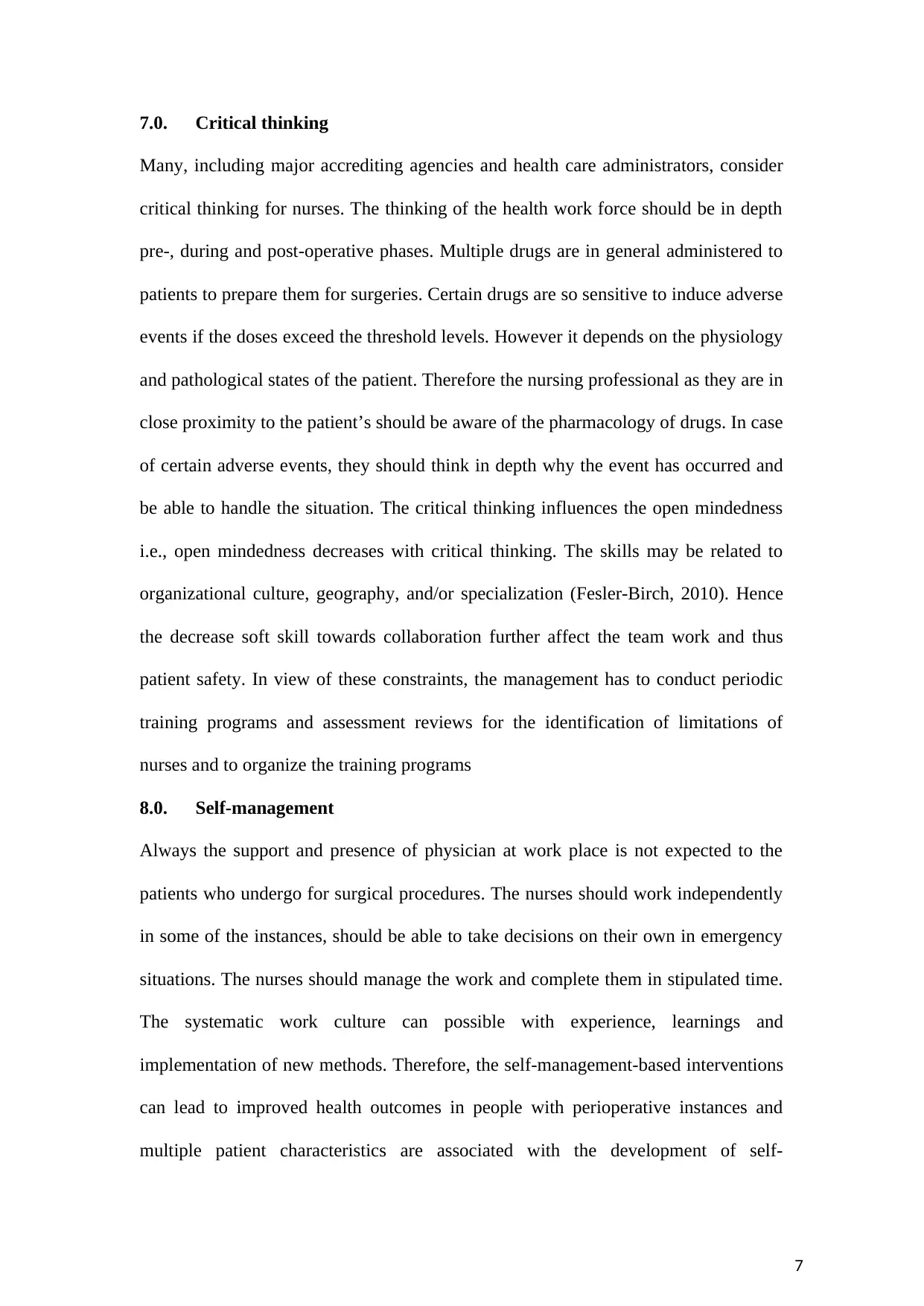
7
7.0. Critical thinking
Many, including major accrediting agencies and health care administrators, consider
critical thinking for nurses. The thinking of the health work force should be in depth
pre-, during and post-operative phases. Multiple drugs are in general administered to
patients to prepare them for surgeries. Certain drugs are so sensitive to induce adverse
events if the doses exceed the threshold levels. However it depends on the physiology
and pathological states of the patient. Therefore the nursing professional as they are in
close proximity to the patient’s should be aware of the pharmacology of drugs. In case
of certain adverse events, they should think in depth why the event has occurred and
be able to handle the situation. The critical thinking influences the open mindedness
i.e., open mindedness decreases with critical thinking. The skills may be related to
organizational culture, geography, and/or specialization (Fesler-Birch, 2010). Hence
the decrease soft skill towards collaboration further affect the team work and thus
patient safety. In view of these constraints, the management has to conduct periodic
training programs and assessment reviews for the identification of limitations of
nurses and to organize the training programs
8.0. Self-management
Always the support and presence of physician at work place is not expected to the
patients who undergo for surgical procedures. The nurses should work independently
in some of the instances, should be able to take decisions on their own in emergency
situations. The nurses should manage the work and complete them in stipulated time.
The systematic work culture can possible with experience, learnings and
implementation of new methods. Therefore, the self-management-based interventions
can lead to improved health outcomes in people with perioperative instances and
multiple patient characteristics are associated with the development of self-
7.0. Critical thinking
Many, including major accrediting agencies and health care administrators, consider
critical thinking for nurses. The thinking of the health work force should be in depth
pre-, during and post-operative phases. Multiple drugs are in general administered to
patients to prepare them for surgeries. Certain drugs are so sensitive to induce adverse
events if the doses exceed the threshold levels. However it depends on the physiology
and pathological states of the patient. Therefore the nursing professional as they are in
close proximity to the patient’s should be aware of the pharmacology of drugs. In case
of certain adverse events, they should think in depth why the event has occurred and
be able to handle the situation. The critical thinking influences the open mindedness
i.e., open mindedness decreases with critical thinking. The skills may be related to
organizational culture, geography, and/or specialization (Fesler-Birch, 2010). Hence
the decrease soft skill towards collaboration further affect the team work and thus
patient safety. In view of these constraints, the management has to conduct periodic
training programs and assessment reviews for the identification of limitations of
nurses and to organize the training programs
8.0. Self-management
Always the support and presence of physician at work place is not expected to the
patients who undergo for surgical procedures. The nurses should work independently
in some of the instances, should be able to take decisions on their own in emergency
situations. The nurses should manage the work and complete them in stipulated time.
The systematic work culture can possible with experience, learnings and
implementation of new methods. Therefore, the self-management-based interventions
can lead to improved health outcomes in people with perioperative instances and
multiple patient characteristics are associated with the development of self-
Paraphrase This Document
Need a fresh take? Get an instant paraphrase of this document with our AI Paraphraser
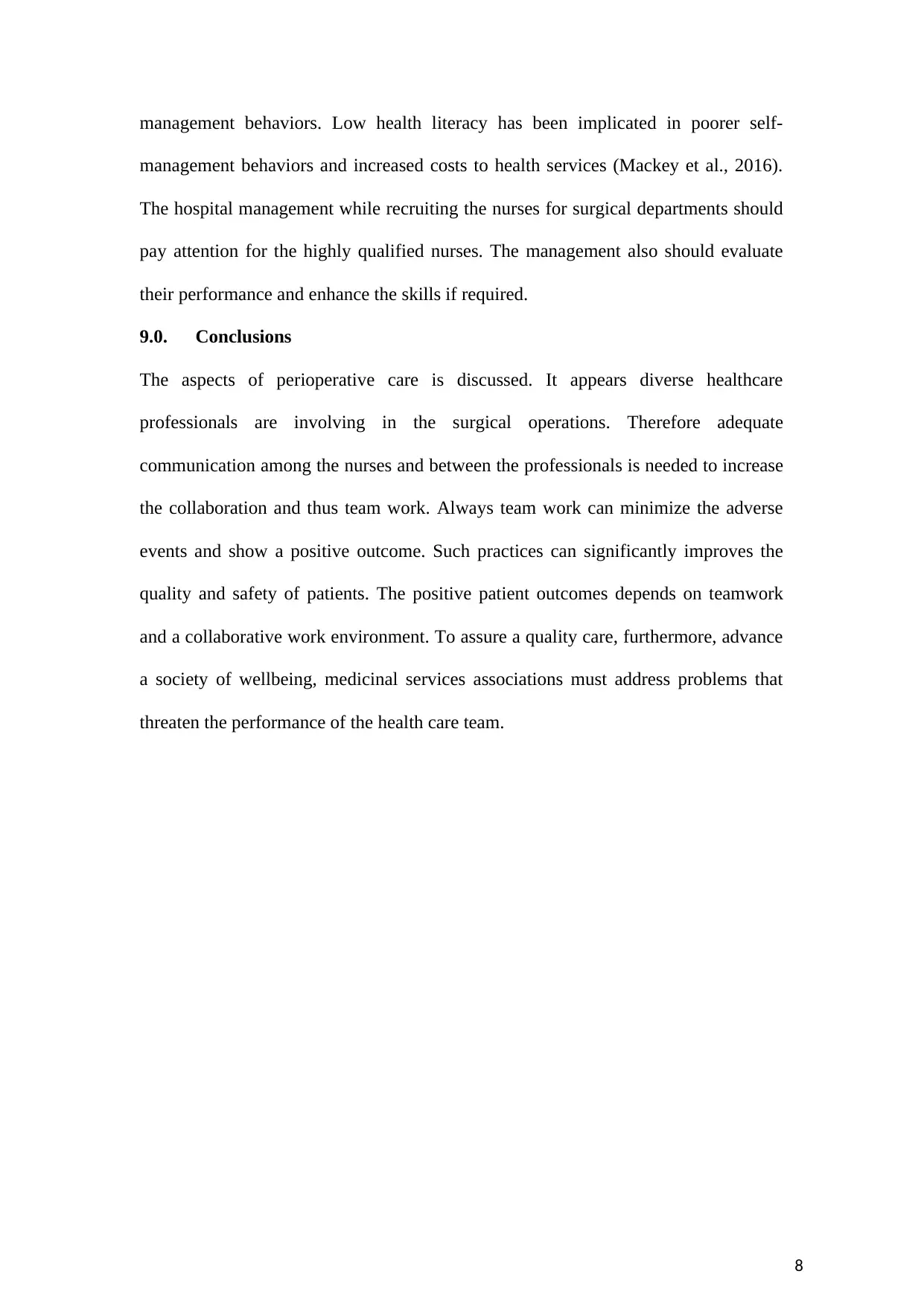
8
management behaviors. Low health literacy has been implicated in poorer self-
management behaviors and increased costs to health services (Mackey et al., 2016).
The hospital management while recruiting the nurses for surgical departments should
pay attention for the highly qualified nurses. The management also should evaluate
their performance and enhance the skills if required.
9.0. Conclusions
The aspects of perioperative care is discussed. It appears diverse healthcare
professionals are involving in the surgical operations. Therefore adequate
communication among the nurses and between the professionals is needed to increase
the collaboration and thus team work. Always team work can minimize the adverse
events and show a positive outcome. Such practices can significantly improves the
quality and safety of patients. The positive patient outcomes depends on teamwork
and a collaborative work environment. To assure a quality care, furthermore, advance
a society of wellbeing, medicinal services associations must address problems that
threaten the performance of the health care team.
management behaviors. Low health literacy has been implicated in poorer self-
management behaviors and increased costs to health services (Mackey et al., 2016).
The hospital management while recruiting the nurses for surgical departments should
pay attention for the highly qualified nurses. The management also should evaluate
their performance and enhance the skills if required.
9.0. Conclusions
The aspects of perioperative care is discussed. It appears diverse healthcare
professionals are involving in the surgical operations. Therefore adequate
communication among the nurses and between the professionals is needed to increase
the collaboration and thus team work. Always team work can minimize the adverse
events and show a positive outcome. Such practices can significantly improves the
quality and safety of patients. The positive patient outcomes depends on teamwork
and a collaborative work environment. To assure a quality care, furthermore, advance
a society of wellbeing, medicinal services associations must address problems that
threaten the performance of the health care team.
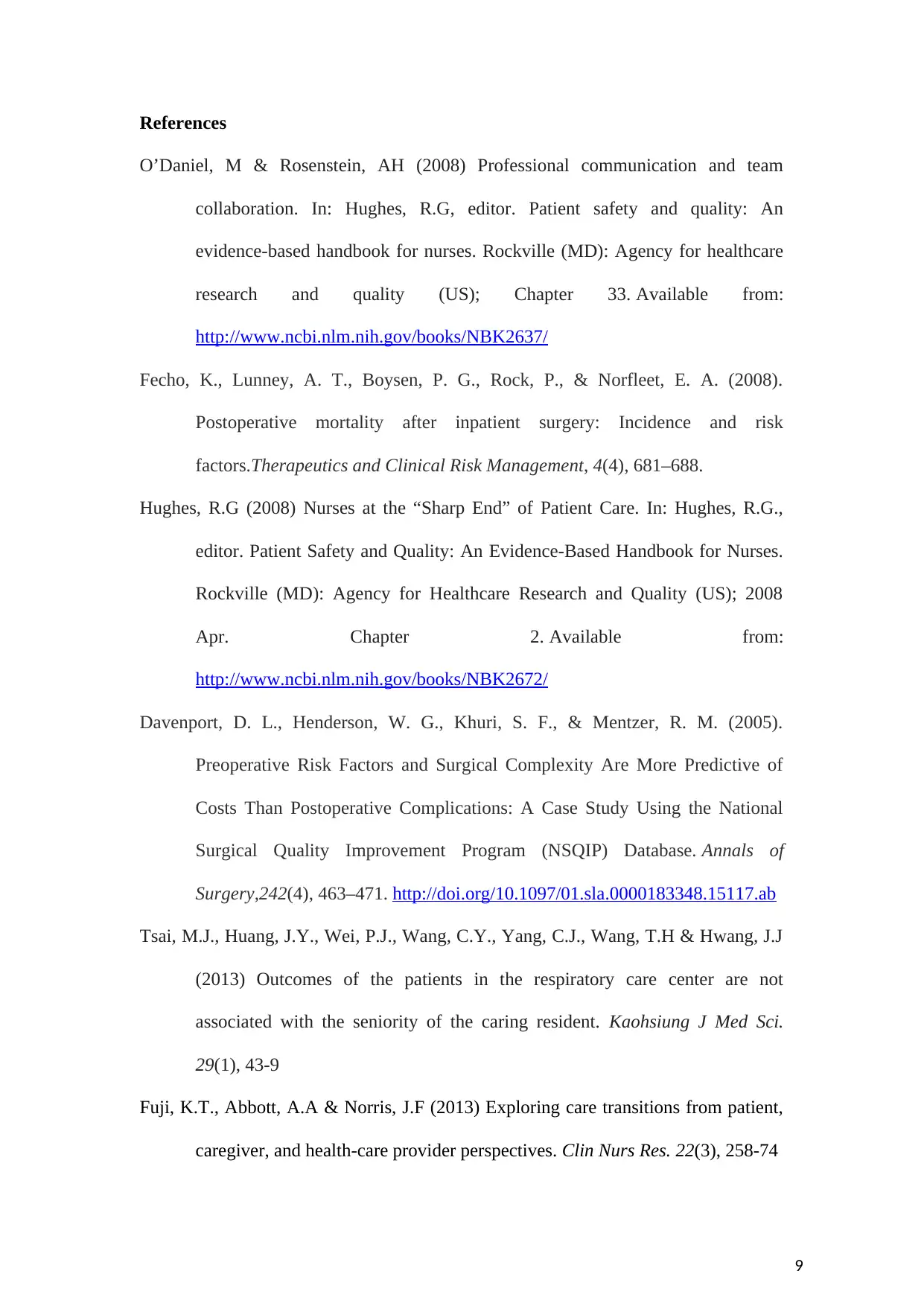
9
References
O’Daniel, M & Rosenstein, AH (2008) Professional communication and team
collaboration. In: Hughes, R.G, editor. Patient safety and quality: An
evidence-based handbook for nurses. Rockville (MD): Agency for healthcare
research and quality (US); Chapter 33. Available from:
http://www.ncbi.nlm.nih.gov/books/NBK2637/
Fecho, K., Lunney, A. T., Boysen, P. G., Rock, P., & Norfleet, E. A. (2008).
Postoperative mortality after inpatient surgery: Incidence and risk
factors.Therapeutics and Clinical Risk Management, 4(4), 681–688.
Hughes, R.G (2008) Nurses at the “Sharp End” of Patient Care. In: Hughes, R.G.,
editor. Patient Safety and Quality: An Evidence-Based Handbook for Nurses.
Rockville (MD): Agency for Healthcare Research and Quality (US); 2008
Apr. Chapter 2. Available from:
http://www.ncbi.nlm.nih.gov/books/NBK2672/
Davenport, D. L., Henderson, W. G., Khuri, S. F., & Mentzer, R. M. (2005).
Preoperative Risk Factors and Surgical Complexity Are More Predictive of
Costs Than Postoperative Complications: A Case Study Using the National
Surgical Quality Improvement Program (NSQIP) Database. Annals of
Surgery,242(4), 463–471. http://doi.org/10.1097/01.sla.0000183348.15117.ab
Tsai, M.J., Huang, J.Y., Wei, P.J., Wang, C.Y., Yang, C.J., Wang, T.H & Hwang, J.J
(2013) Outcomes of the patients in the respiratory care center are not
associated with the seniority of the caring resident. Kaohsiung J Med Sci.
29(1), 43-9
Fuji, K.T., Abbott, A.A & Norris, J.F (2013) Exploring care transitions from patient,
caregiver, and health-care provider perspectives. Clin Nurs Res. 22(3), 258-74
References
O’Daniel, M & Rosenstein, AH (2008) Professional communication and team
collaboration. In: Hughes, R.G, editor. Patient safety and quality: An
evidence-based handbook for nurses. Rockville (MD): Agency for healthcare
research and quality (US); Chapter 33. Available from:
http://www.ncbi.nlm.nih.gov/books/NBK2637/
Fecho, K., Lunney, A. T., Boysen, P. G., Rock, P., & Norfleet, E. A. (2008).
Postoperative mortality after inpatient surgery: Incidence and risk
factors.Therapeutics and Clinical Risk Management, 4(4), 681–688.
Hughes, R.G (2008) Nurses at the “Sharp End” of Patient Care. In: Hughes, R.G.,
editor. Patient Safety and Quality: An Evidence-Based Handbook for Nurses.
Rockville (MD): Agency for Healthcare Research and Quality (US); 2008
Apr. Chapter 2. Available from:
http://www.ncbi.nlm.nih.gov/books/NBK2672/
Davenport, D. L., Henderson, W. G., Khuri, S. F., & Mentzer, R. M. (2005).
Preoperative Risk Factors and Surgical Complexity Are More Predictive of
Costs Than Postoperative Complications: A Case Study Using the National
Surgical Quality Improvement Program (NSQIP) Database. Annals of
Surgery,242(4), 463–471. http://doi.org/10.1097/01.sla.0000183348.15117.ab
Tsai, M.J., Huang, J.Y., Wei, P.J., Wang, C.Y., Yang, C.J., Wang, T.H & Hwang, J.J
(2013) Outcomes of the patients in the respiratory care center are not
associated with the seniority of the caring resident. Kaohsiung J Med Sci.
29(1), 43-9
Fuji, K.T., Abbott, A.A & Norris, J.F (2013) Exploring care transitions from patient,
caregiver, and health-care provider perspectives. Clin Nurs Res. 22(3), 258-74
⊘ This is a preview!⊘
Do you want full access?
Subscribe today to unlock all pages.

Trusted by 1+ million students worldwide
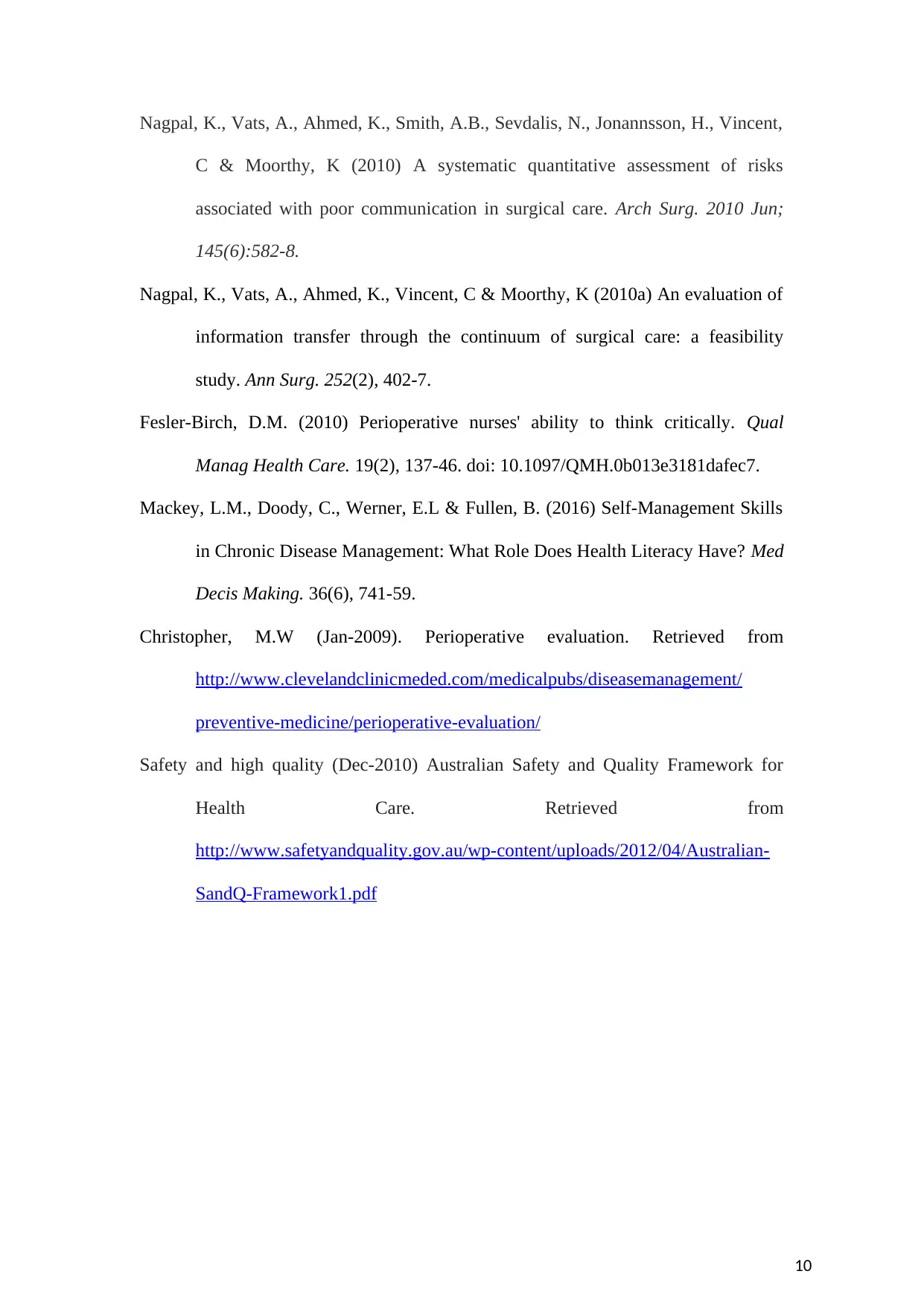
10
Nagpal, K., Vats, A., Ahmed, K., Smith, A.B., Sevdalis, N., Jonannsson, H., Vincent,
C & Moorthy, K (2010) A systematic quantitative assessment of risks
associated with poor communication in surgical care. Arch Surg. 2010 Jun;
145(6):582-8.
Nagpal, K., Vats, A., Ahmed, K., Vincent, C & Moorthy, K (2010a) An evaluation of
information transfer through the continuum of surgical care: a feasibility
study. Ann Surg. 252(2), 402-7.
Fesler-Birch, D.M. (2010) Perioperative nurses' ability to think critically. Qual
Manag Health Care. 19(2), 137-46. doi: 10.1097/QMH.0b013e3181dafec7.
Mackey, L.M., Doody, C., Werner, E.L & Fullen, B. (2016) Self-Management Skills
in Chronic Disease Management: What Role Does Health Literacy Have? Med
Decis Making. 36(6), 741-59.
Christopher, M.W (Jan-2009). Perioperative evaluation. Retrieved from
http://www.clevelandclinicmeded.com/medicalpubs/diseasemanagement/
preventive-medicine/perioperative-evaluation/
Safety and high quality (Dec-2010) Australian Safety and Quality Framework for
Health Care. Retrieved from
http://www.safetyandquality.gov.au/wp-content/uploads/2012/04/Australian-
SandQ-Framework1.pdf
Nagpal, K., Vats, A., Ahmed, K., Smith, A.B., Sevdalis, N., Jonannsson, H., Vincent,
C & Moorthy, K (2010) A systematic quantitative assessment of risks
associated with poor communication in surgical care. Arch Surg. 2010 Jun;
145(6):582-8.
Nagpal, K., Vats, A., Ahmed, K., Vincent, C & Moorthy, K (2010a) An evaluation of
information transfer through the continuum of surgical care: a feasibility
study. Ann Surg. 252(2), 402-7.
Fesler-Birch, D.M. (2010) Perioperative nurses' ability to think critically. Qual
Manag Health Care. 19(2), 137-46. doi: 10.1097/QMH.0b013e3181dafec7.
Mackey, L.M., Doody, C., Werner, E.L & Fullen, B. (2016) Self-Management Skills
in Chronic Disease Management: What Role Does Health Literacy Have? Med
Decis Making. 36(6), 741-59.
Christopher, M.W (Jan-2009). Perioperative evaluation. Retrieved from
http://www.clevelandclinicmeded.com/medicalpubs/diseasemanagement/
preventive-medicine/perioperative-evaluation/
Safety and high quality (Dec-2010) Australian Safety and Quality Framework for
Health Care. Retrieved from
http://www.safetyandquality.gov.au/wp-content/uploads/2012/04/Australian-
SandQ-Framework1.pdf
1 out of 10
Related Documents
Your All-in-One AI-Powered Toolkit for Academic Success.
+13062052269
info@desklib.com
Available 24*7 on WhatsApp / Email
![[object Object]](/_next/static/media/star-bottom.7253800d.svg)
Unlock your academic potential
Copyright © 2020–2025 A2Z Services. All Rights Reserved. Developed and managed by ZUCOL.





